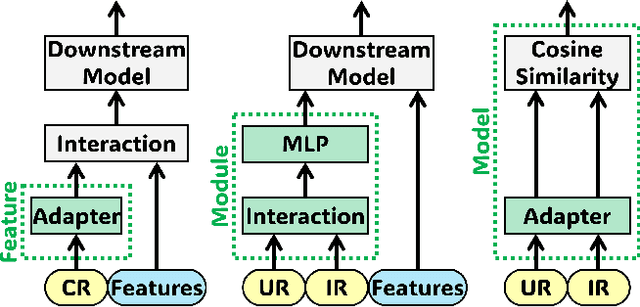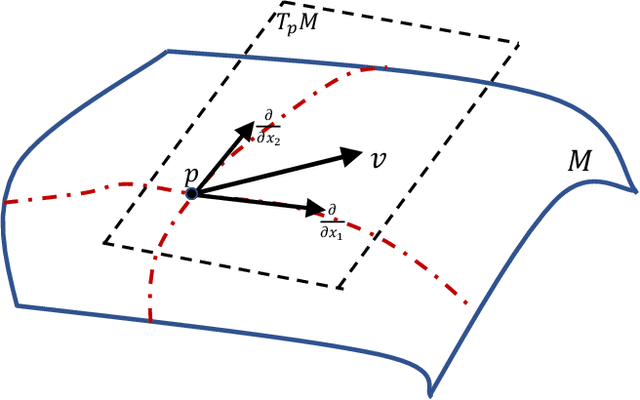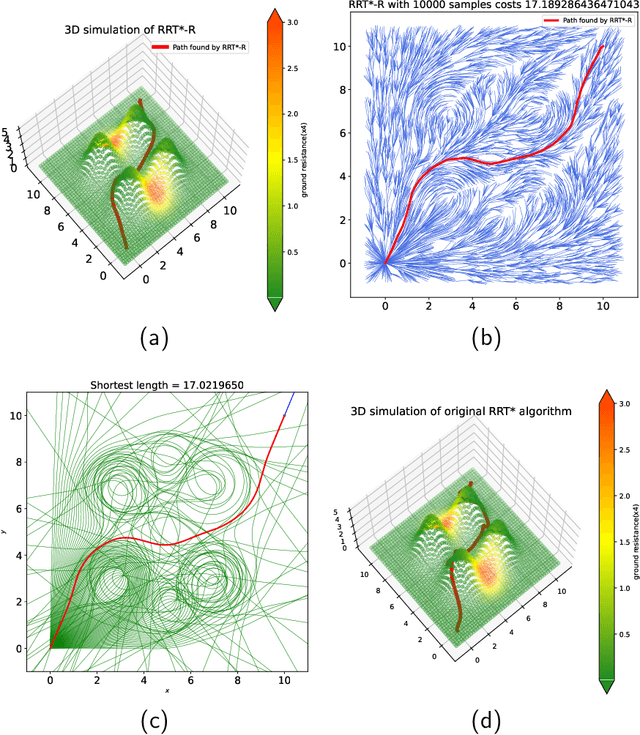Qi Zhou
Large Foundation Model for Ads Recommendation
Aug 20, 2025



Abstract:Online advertising relies on accurate recommendation models, with recent advances using pre-trained large-scale foundation models (LFMs) to capture users' general interests across multiple scenarios and tasks. However, existing methods have critical limitations: they extract and transfer only user representations (URs), ignoring valuable item representations (IRs) and user-item cross representations (CRs); and they simply use a UR as a feature in downstream applications, which fails to bridge upstream-downstream gaps and overlooks more transfer granularities. In this paper, we propose LFM4Ads, an All-Representation Multi-Granularity transfer framework for ads recommendation. It first comprehensively transfers URs, IRs, and CRs, i.e., all available representations in the pre-trained foundation model. To effectively utilize the CRs, it identifies the optimal extraction layer and aggregates them into transferable coarse-grained forms. Furthermore, we enhance the transferability via multi-granularity mechanisms: non-linear adapters for feature-level transfer, an Isomorphic Interaction Module for module-level transfer, and Standalone Retrieval for model-level transfer. LFM4Ads has been successfully deployed in Tencent's industrial-scale advertising platform, processing tens of billions of daily samples while maintaining terabyte-scale model parameters with billions of sparse embedding keys across approximately two thousand features. Since its production deployment in Q4 2024, LFM4Ads has achieved 10+ successful production launches across various advertising scenarios, including primary ones like Weixin Moments and Channels. These launches achieve an overall GMV lift of 2.45% across the entire platform, translating to estimated annual revenue increases in the hundreds of millions of dollars.
InfiAlign: A Scalable and Sample-Efficient Framework for Aligning LLMs to Enhance Reasoning Capabilities
Aug 07, 2025Abstract:Large language models (LLMs) have exhibited impressive reasoning abilities on a wide range of complex tasks. However, enhancing these capabilities through post-training remains resource intensive, particularly in terms of data and computational cost. Although recent efforts have sought to improve sample efficiency through selective data curation, existing methods often rely on heuristic or task-specific strategies that hinder scalability. In this work, we introduce InfiAlign, a scalable and sample-efficient post-training framework that integrates supervised fine-tuning (SFT) with Direct Preference Optimization (DPO) to align LLMs for enhanced reasoning. At the core of InfiAlign is a robust data selection pipeline that automatically curates high-quality alignment data from open-source reasoning datasets using multidimensional quality metrics. This pipeline enables significant performance gains while drastically reducing data requirements and remains extensible to new data sources. When applied to the Qwen2.5-Math-7B-Base model, our SFT model achieves performance on par with DeepSeek-R1-Distill-Qwen-7B, while using only approximately 12% of the training data, and demonstrates strong generalization across diverse reasoning tasks. Additional improvements are obtained through the application of DPO, with particularly notable gains in mathematical reasoning tasks. The model achieves an average improvement of 3.89% on AIME 24/25 benchmarks. Our results highlight the effectiveness of combining principled data selection with full-stage post-training, offering a practical solution for aligning large reasoning models in a scalable and data-efficient manner. The model checkpoints are available at https://huggingface.co/InfiX-ai/InfiAlign-Qwen-7B-SFT.
An RRT* algorithm based on Riemannian metric model for optimal path planning
Jul 02, 2025



Abstract:This paper presents a Riemannian metric-based model to solve the optimal path planning problem on two-dimensional smooth submanifolds in high-dimensional space. Our model is based on constructing a new Riemannian metric on a two-dimensional projection plane, which is induced by the high-dimensional Euclidean metric on two-dimensional smooth submanifold and reflects the environmental information of the robot. The optimal path planning problem in high-dimensional space is therefore transformed into a geometric problem on the two-dimensional plane with new Riemannian metric. Based on the new Riemannian metric, we proposed an incremental algorithm RRT*-R on the projection plane. The experimental results show that the proposed algorithm is suitable for scenarios with uneven fields in multiple dimensions. The proposed algorithm can help the robot to effectively avoid areas with drastic changes in height, ground resistance and other environmental factors. More importantly, the RRT*-R algorithm shows better smoothness and optimization properties compared with the original RRT* algorithm using Euclidean distance in high-dimensional workspace. The length of the entire path by RRT*-R is a good approximation of the theoretical minimum geodesic distance on projection plane.
InfiFPO: Implicit Model Fusion via Preference Optimization in Large Language Models
May 20, 2025Abstract:Model fusion combines multiple Large Language Models (LLMs) with different strengths into a more powerful, integrated model through lightweight training methods. Existing works on model fusion focus primarily on supervised fine-tuning (SFT), leaving preference alignment (PA) --a critical phase for enhancing LLM performance--largely unexplored. The current few fusion methods on PA phase, like WRPO, simplify the process by utilizing only response outputs from source models while discarding their probability information. To address this limitation, we propose InfiFPO, a preference optimization method for implicit model fusion. InfiFPO replaces the reference model in Direct Preference Optimization (DPO) with a fused source model that synthesizes multi-source probabilities at the sequence level, circumventing complex vocabulary alignment challenges in previous works and meanwhile maintaining the probability information. By introducing probability clipping and max-margin fusion strategies, InfiFPO enables the pivot model to align with human preferences while effectively distilling knowledge from source models. Comprehensive experiments on 11 widely-used benchmarks demonstrate that InfiFPO consistently outperforms existing model fusion and preference optimization methods. When using Phi-4 as the pivot model, InfiFPO improve its average performance from 79.95 to 83.33 on 11 benchmarks, significantly improving its capabilities in mathematics, coding, and reasoning tasks.
InfiGFusion: Graph-on-Logits Distillation via Efficient Gromov-Wasserstein for Model Fusion
May 20, 2025Abstract:Recent advances in large language models (LLMs) have intensified efforts to fuse heterogeneous open-source models into a unified system that inherits their complementary strengths. Existing logit-based fusion methods maintain inference efficiency but treat vocabulary dimensions independently, overlooking semantic dependencies encoded by cross-dimension interactions. These dependencies reflect how token types interact under a model's internal reasoning and are essential for aligning models with diverse generation behaviors. To explicitly model these dependencies, we propose \textbf{InfiGFusion}, the first structure-aware fusion framework with a novel \textit{Graph-on-Logits Distillation} (GLD) loss. Specifically, we retain the top-$k$ logits per output and aggregate their outer products across sequence positions to form a global co-activation graph, where nodes represent vocabulary channels and edges quantify their joint activations. To ensure scalability and efficiency, we design a sorting-based closed-form approximation that reduces the original $O(n^4)$ cost of Gromov-Wasserstein distance to $O(n \log n)$, with provable approximation guarantees. Experiments across multiple fusion settings show that GLD consistently improves fusion quality and stability. InfiGFusion outperforms SOTA models and fusion baselines across 11 benchmarks spanning reasoning, coding, and mathematics. It shows particular strength in complex reasoning tasks, with +35.6 improvement on Multistep Arithmetic and +37.06 on Causal Judgement over SFT, demonstrating superior multi-step and relational inference.
Fair-PP: A Synthetic Dataset for Aligning LLM with Personalized Preferences of Social Equity
May 17, 2025Abstract:Human preference plays a crucial role in the refinement of large language models (LLMs). However, collecting human preference feedback is costly and most existing datasets neglect the correlation between personalization and preferences. To address this issue, we introduce Fair-PP, a synthetic dataset of personalized preferences targeting social equity, derived from real-world social survey data, which includes 28 social groups, 98 equity topics, and 5 personal preference dimensions. Leveraging GPT-4o-mini, we engage in role-playing based on seven representative persona portrayals guided by existing social survey data, yielding a total of 238,623 preference records. Through Fair-PP, we also contribute (i) An automated framework for generating preference data, along with a more fine-grained dataset of personalized preferences; (ii) analysis of the positioning of the existing mainstream LLMs across five major global regions within the personalized preference space; and (iii) a sample reweighting method for personalized preference alignment, enabling alignment with a target persona while maximizing the divergence from other personas. Empirical experiments show our method outperforms the baselines.
DFVO: Learning Darkness-free Visible and Infrared Image Disentanglement and Fusion All at Once
May 07, 2025Abstract:Visible and infrared image fusion is one of the most crucial tasks in the field of image fusion, aiming to generate fused images with clear structural information and high-quality texture features for high-level vision tasks. However, when faced with severe illumination degradation in visible images, the fusion results of existing image fusion methods often exhibit blurry and dim visual effects, posing major challenges for autonomous driving. To this end, a Darkness-Free network is proposed to handle Visible and infrared image disentanglement and fusion all at Once (DFVO), which employs a cascaded multi-task approach to replace the traditional two-stage cascaded training (enhancement and fusion), addressing the issue of information entropy loss caused by hierarchical data transmission. Specifically, we construct a latent-common feature extractor (LCFE) to obtain latent features for the cascaded tasks strategy. Firstly, a details-extraction module (DEM) is devised to acquire high-frequency semantic information. Secondly, we design a hyper cross-attention module (HCAM) to extract low-frequency information and preserve texture features from source images. Finally, a relevant loss function is designed to guide the holistic network learning, thereby achieving better image fusion. Extensive experiments demonstrate that our proposed approach outperforms state-of-the-art alternatives in terms of qualitative and quantitative evaluations. Particularly, DFVO can generate clearer, more informative, and more evenly illuminated fusion results in the dark environments, achieving best performance on the LLVIP dataset with 63.258 dB PSNR and 0.724 CC, providing more effective information for high-level vision tasks. Our code is publicly accessible at https://github.com/DaVin-Qi530/DFVO.
A Novel Solution for Drone Photogrammetry with Low-overlap Aerial Images using Monocular Depth Estimation
Mar 06, 2025



Abstract:Low-overlap aerial imagery poses significant challenges to traditional photogrammetric methods, which rely heavily on high image overlap to produce accurate and complete mapping products. In this study, we propose a novel workflow based on monocular depth estimation to address the limitations of conventional techniques. Our method leverages tie points obtained from aerial triangulation to establish a relationship between monocular depth and metric depth, thus transforming the original depth map into a metric depth map, enabling the generation of dense depth information and the comprehensive reconstruction of the scene. For the experiments, a high-overlap drone dataset containing 296 images is processed using Metashape to generate depth maps and DSMs as ground truth. Subsequently, we create a low-overlap dataset by selecting 20 images for experimental evaluation. Results demonstrate that while the recovered depth maps and resulting DSMs achieve meter-level accuracy, they provide significantly better completeness compared to traditional methods, particularly in regions covered by single images. This study showcases the potential of monocular depth estimation in low-overlap aerial photogrammetry.
InfiR : Crafting Effective Small Language Models and Multimodal Small Language Models in Reasoning
Feb 17, 2025



Abstract:Large Language Models (LLMs) and Multimodal Large Language Models (MLLMs) have made significant advancements in reasoning capabilities. However, they still face challenges such as high computational demands and privacy concerns. This paper focuses on developing efficient Small Language Models (SLMs) and Multimodal Small Language Models (MSLMs) that retain competitive reasoning abilities. We introduce a novel training pipeline that enhances reasoning capabilities and facilitates deployment on edge devices, achieving state-of-the-art performance while minimizing development costs. \InfR~ aims to advance AI systems by improving reasoning, reducing adoption barriers, and addressing privacy concerns through smaller model sizes. Resources are available at https://github. com/Reallm-Labs/InfiR.
InfiFusion: A Unified Framework for Enhanced Cross-Model Reasoning via LLM Fusion
Jan 06, 2025
Abstract:Large Language Models (LLMs) have demonstrated strong performance across various reasoning tasks, yet building a single model that consistently excels across all domains remains challenging. This paper addresses this problem by exploring strategies to integrate multiple domain-specialized models into an efficient pivot model.We propose two fusion strategies to combine the strengths of multiple LLMs: (1) a pairwise, multi-step fusion approach that sequentially distills each source model into the pivot model, followed by a weight merging step to integrate the distilled models into the final model. This method achieves strong performance but requires substantial training effort; and (2) a unified fusion approach that aggregates all source models' outputs simultaneously.To improve the fusion process, we introduce a novel Rate-Skewness Adaptive Fusion (RSAF) technique, which dynamically adjusts top-K ratios during parameter merging for enhanced flexibility and stability.Furthermore, we propose an uncertainty-based weighting method for the unified approach, which dynamically balances the contributions of source models and outperforms other logits/distribution ensemble methods.We achieved accuracy improvements of 9.27%, 8.80%, and 8.89% on the GSM8K, MATH, and HumanEval tasks, respectively.
 Add to Chrome
Add to Chrome Add to Firefox
Add to Firefox Add to Edge
Add to Edge